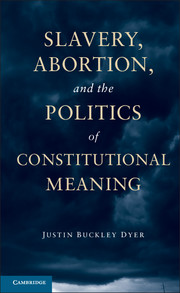Book contents
- Frontmatter
- Contents
- Acknowledgments
- Preface
- 1 The Conscience of a Nation
- 2 Substance, Procedure, and Fourteenth Amendment Rights
- 3 Dred Scott, Lochner, and the New Abortion Liberty
- 4 Constitutional Disharmony after Roe
- 5 The Politics of Abortion History
- 6 Private Morality, Public Reasons
- 7 Personhood and the Ethics of Life
- Index
- References
7 - Personhood and the Ethics of Life
Published online by Cambridge University Press: 05 April 2013
- Frontmatter
- Contents
- Acknowledgments
- Preface
- 1 The Conscience of a Nation
- 2 Substance, Procedure, and Fourteenth Amendment Rights
- 3 Dred Scott, Lochner, and the New Abortion Liberty
- 4 Constitutional Disharmony after Roe
- 5 The Politics of Abortion History
- 6 Private Morality, Public Reasons
- 7 Personhood and the Ethics of Life
- Index
- References
Summary
The central question in the abortion debates, as Richard John Neuhaus long contended, is simply, “Who belongs to the community for which we accept common responsibility?” For many of the most influential voices in the academic debate about the ethics and legality of abortion, the answer to this question hinges on some conception of personhood. “Beginning in the ancient world,” John Rawls noted, “the concept of the person has been understood, in both philosophy and law, as the concept of someone who can take part in, or who can play a role in, social life, and hence exercise and respect its various rights and duties.” A person is a member of the political and social community, whereas a non-person stands outside of that community and can neither claim its rights nor be subject to its obligations.
In his Dred Scott opinion, Roger Taney made such a conception of personhood central to the question of whether African slaves and their descendants could ever claim American citizenship, and Taney’s suggestion that African slaves formed no part of “the people” for whom the Constitution was written was a historical claim about conventional rights and duties. For “more than a century,” Taney maintained, slaves were “regarded as beings of an inferior order . . . and so far inferior that they had no rights which the white man was bound to respect.” Having no legal rights, the slave was “bought and sold, and treated as an ordinary article of merchandise and traffic whenever a profit could be made by it.” Although Taney’s simplistic reading of history was challenged by the dissenting opinions of Benjamin Curtis and John McLean, it was of course true that slaves were treated as property, and therefore something less than full persons, throughout much of the eighteenth and nineteenth centuries.
- Type
- Chapter
- Information
- Slavery, Abortion, and the Politics of Constitutional Meaning , pp. 156 - 188Publisher: Cambridge University PressPrint publication year: 2013

